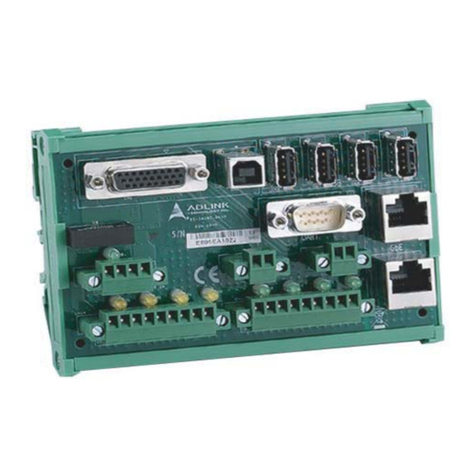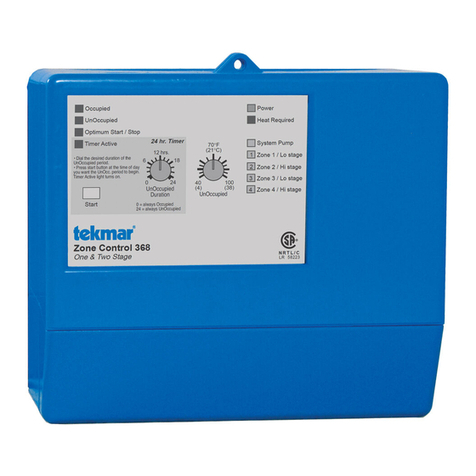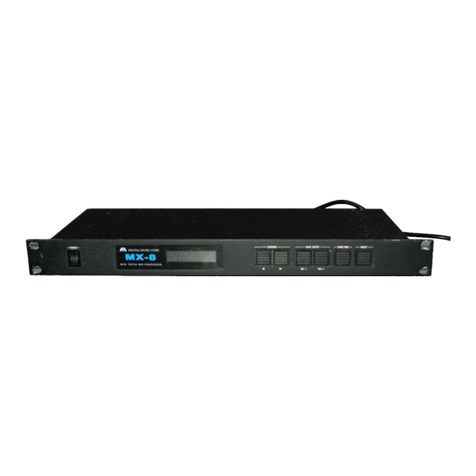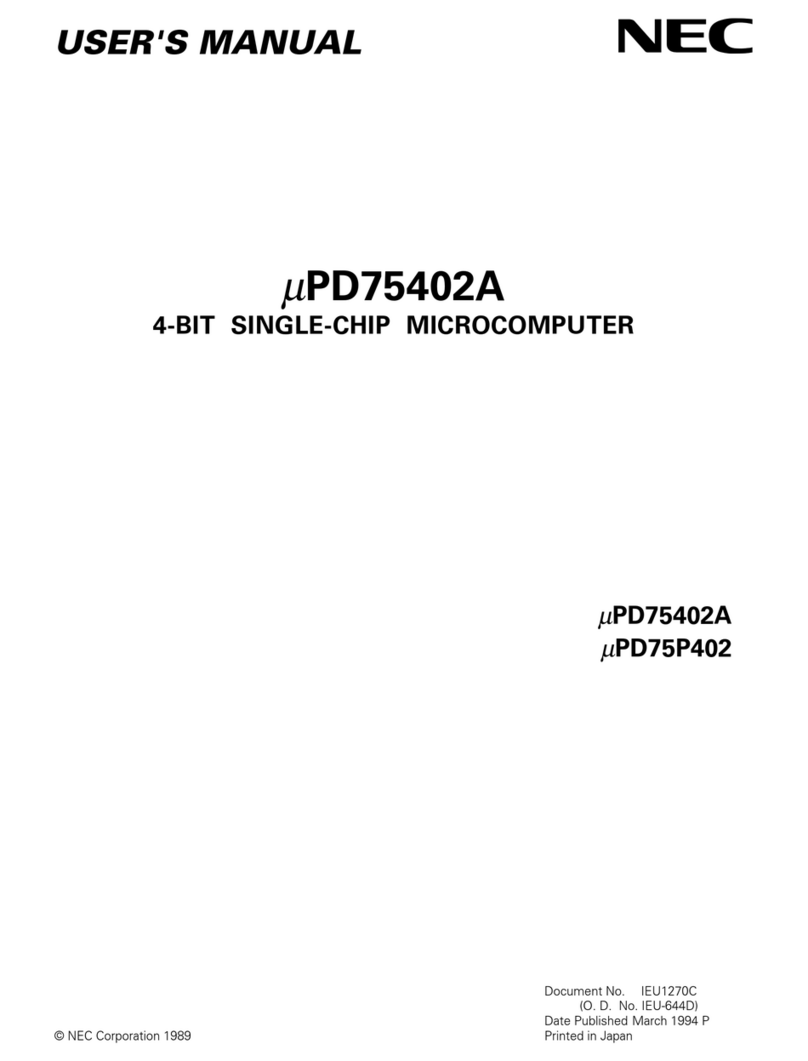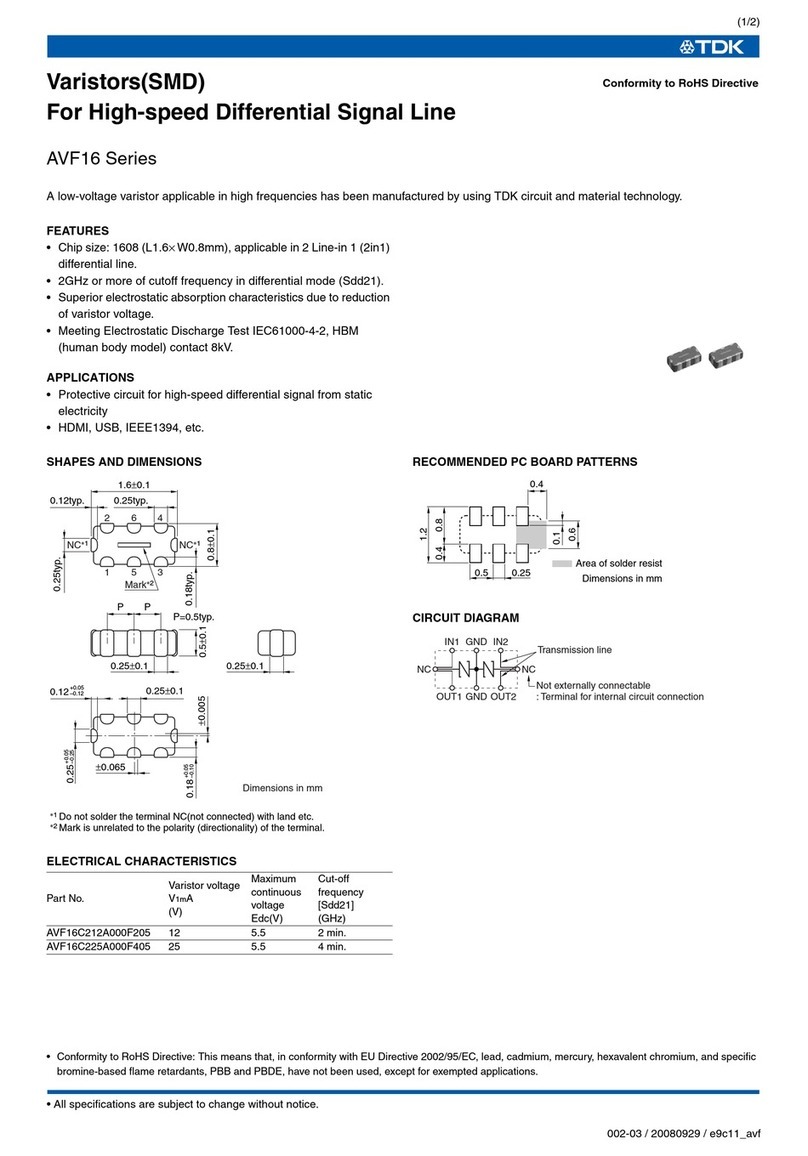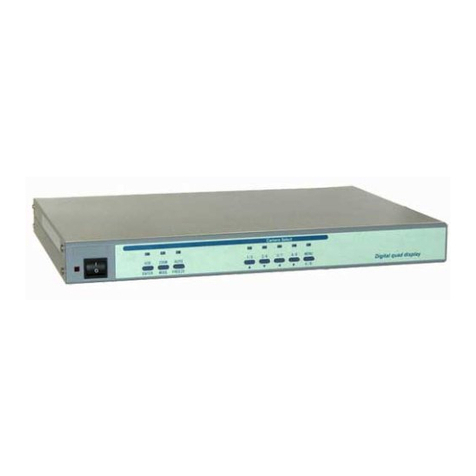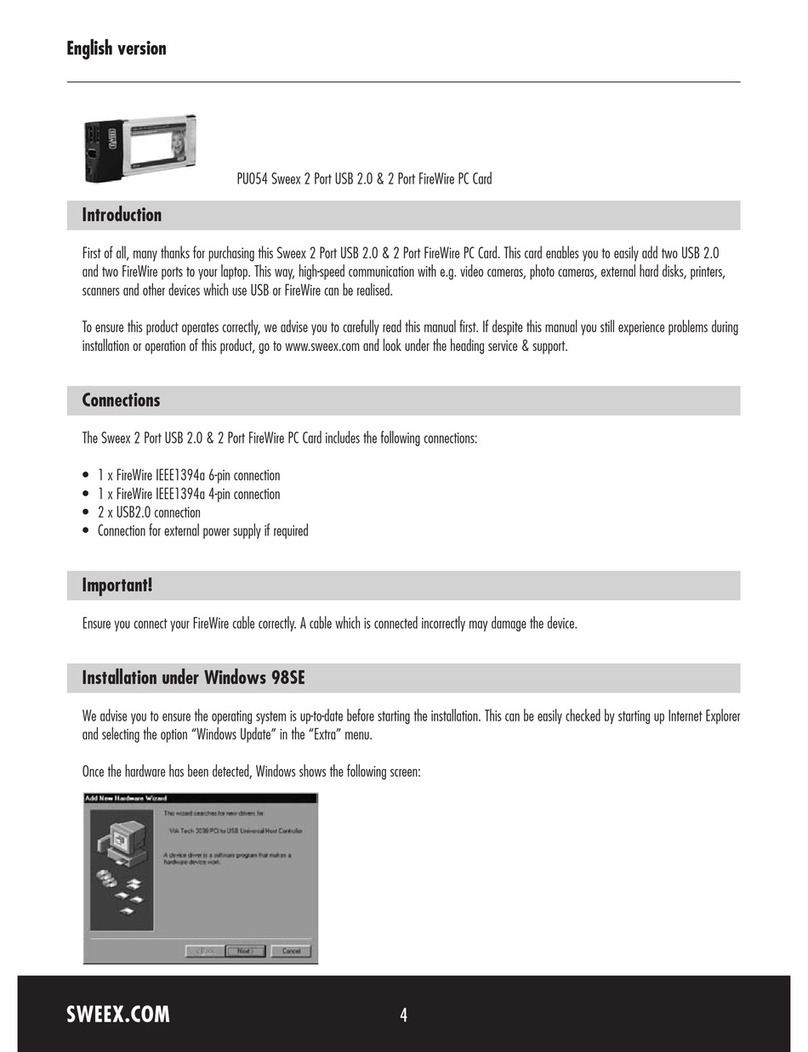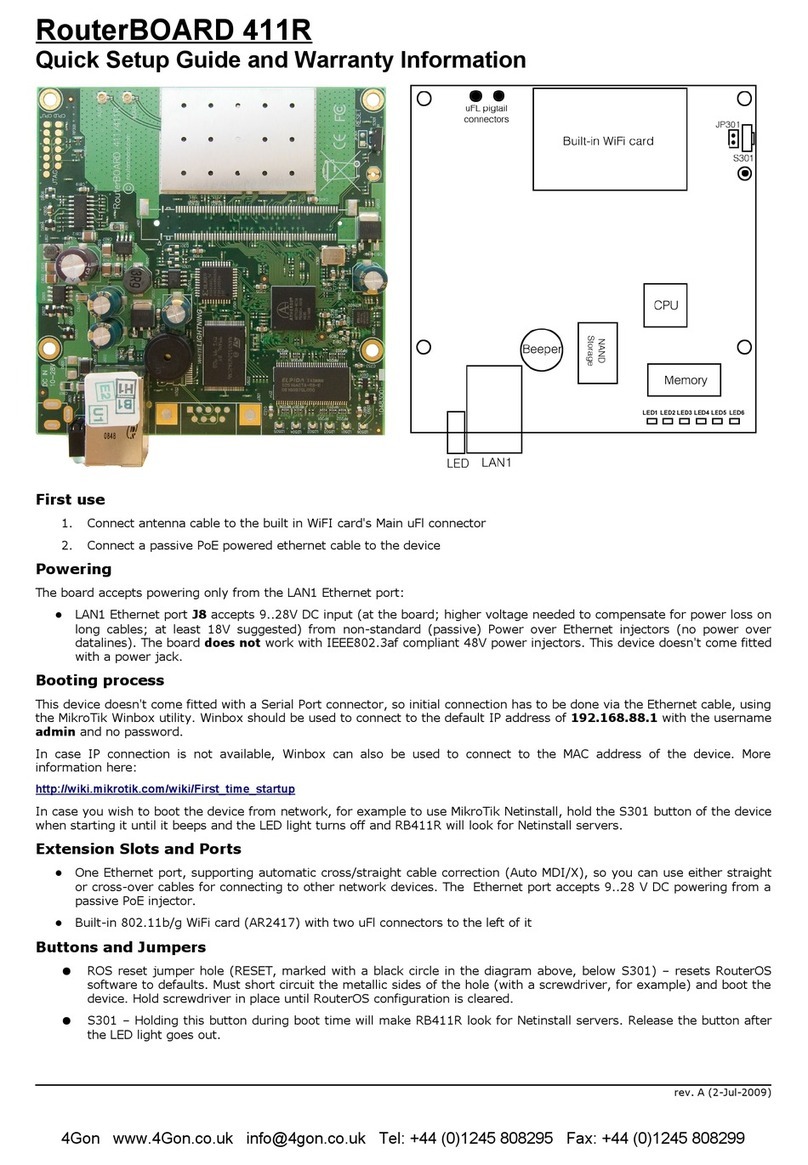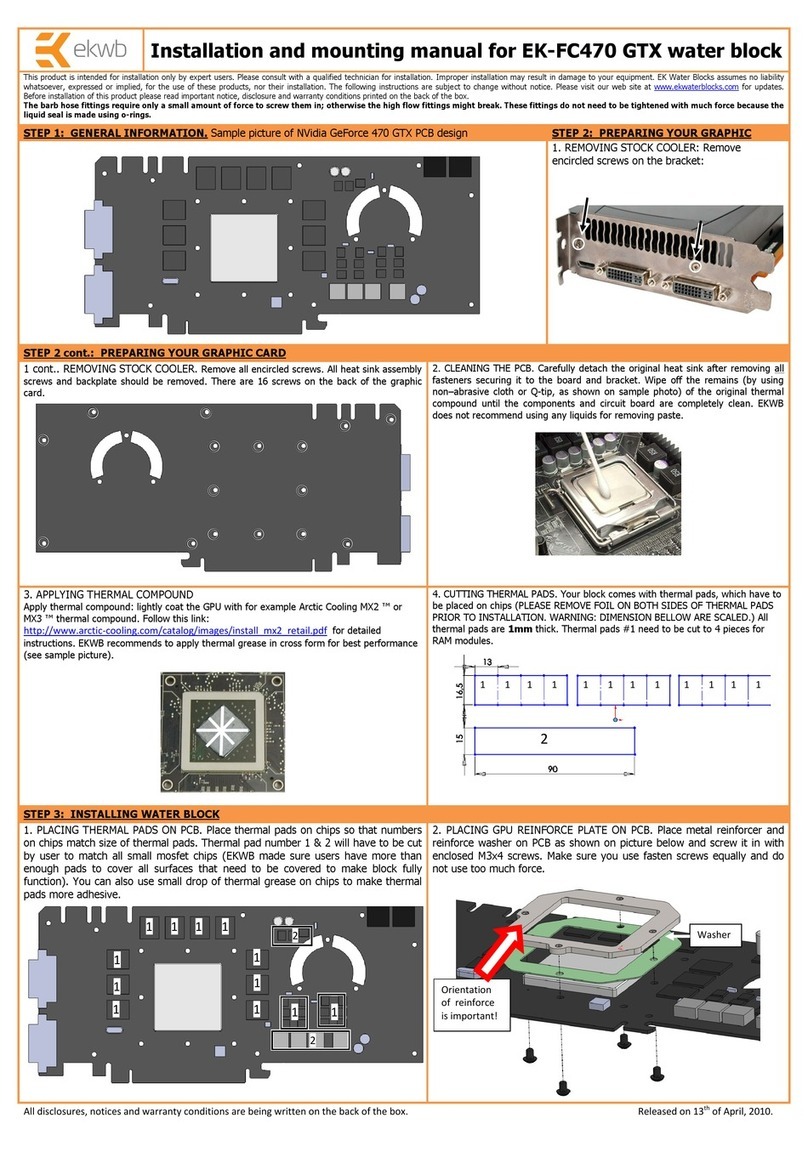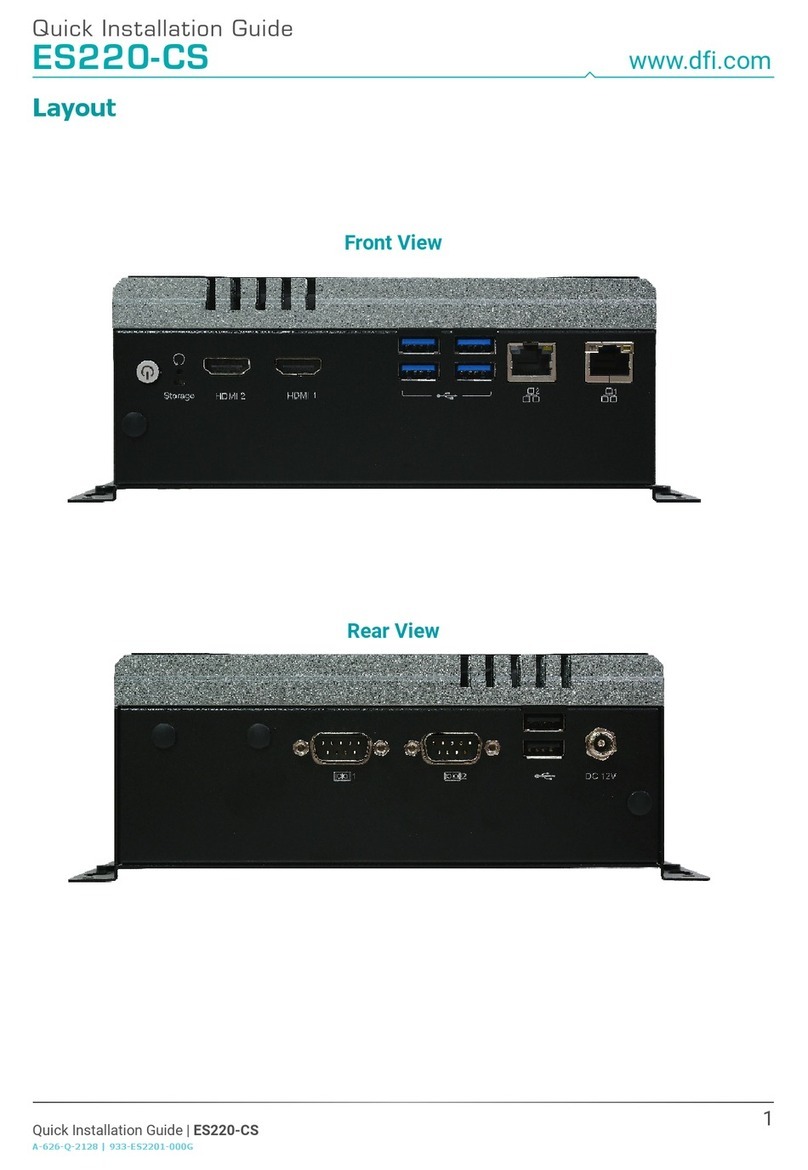CRL Systems SMP-900 User manual

SMP -
900
AM
STEREO
MATRIX
PROCESSOR
INSTALLATION
AND
OPERATION
MANUAL
THE
PROFESSIONAL'S
CHOICE
SYSTEMS
fflOIMMIL
— =
1M
ffl
Circuit
Research
Labs,
Inc.
2522
West
Geneva
Drive
Tempe,
Arizona
85282-3192
U.S.A.
(800)
535-7648 (
602)
438-0888
FAX
438-8227
lom

SMP-900
AM
STEREO
MATRIX
PROCESSOR
INSTALLATION
AND
OPERATION
MANUAL
1
PROPRIETARY
NOTICE
The
schematic
drawings
reproduced
in
this
manual
contain
top.
proprietary
data
to
Circuit
Research
Labs,
Inc.
The
user
of
this
manual
agrees
to
make
no
disclosure,
reproductions
or
use
of
any
pert
of
these
drawings
except
by
prior
written
permission
from
Circuit
Research
Labs,
Inc.
I.
CIRCUIT
RESEARCH
LABS.
INC.
2522
W.
Geneva
Drive,
Tempe,
AZ
85282
1-602-438-0888
P/N
10140
DWNG
11-9000-01
rs

TABLE
OF
CONTENTS
Page
1.
GENERAL
1.1
INTRODUCTION
1-1
1.2
AM
STEREO
THEORY
1-1
1.3
WARRANTY
1-6
2.
INSTALLATION
2.1
INSTALLATION
PROCEDURE
2-1
2.2
INPUT
AND
OUTPUT
CONNECTIONS
2-1
2.3
INITIAL CONTROL
SETTINGS
2-1
2.4
SET
UP,
PREFERRED
2-3
2.5
ALTERNATE
SET
UP
WITH
MODULATION
MONITOR . • •
2-5
2.6
SET
UP
OF
NEGATIVE
LIMITING
2-5
2.7
INTERNAL
OPTIONS
2-6
2.8
INITIAL
SOUND
SETTINGS
2-7
3.
OPERATION
3.1
CONTROL
LISTING
3-1
3.2
FRONT
PANEL
CONTROLS
3-1
3.3
REAR
PANEL
CONTROLS
3-4
3.4
INTERNAL
JUMPERS
3-6
3.5
INTERNAL
ALIGNMENT
3-7
4.
MAINTENANCE
4.1
PREVENTIVE
MAINTENANCE
4-1
4.2
TROUBLESHOOTING
4-1
4.3
FACTORY
SERVICE
AND
REPAIR
4-2
5.
APPENDIX
5.1
LOW
FREQUENCY
TILT
CORRECTION
5.2
AM4S
SYSTEM
INFORMATION
5.3
USING
THE
SMP900
IN
MONO
5.4
PARTS
LIST
5.5
SCHEMATIC
DIAGRAMS
P/N
10140
DWNG
11-9000-01

LIST
OF
ILLUSTRATIONS
Figure
1-1
CONVENTIONAL
STEREO
LIMITING
PATTERN
1-2
MATRIX STEREO
LIMITING
PATTERN
1-3
CRL
STEREO
LIMITING
PATTERN
5-1
NORMAL
MODULATION
ENVELOPE
5-2
UNDER
CORRECTED
MODULATION
ENVELOPE
5-3
OVER
CORRECTED
MODULATION
ENVELOPE
5-4
MONO
INPUT PAD
5-5
MONO
JUMPER
LOCATIONS
P/N
10140
DWNG
11-9000-01

SECTION
1 -
INSTALLATION
1.1
INTRODUCTION
This
manual
provides
information
on
the
theory
of
operation,
installation,
and
alignment
for
the
CRL
AM-
2S
and AM-
4S
STEREO
MATRIX
processing
systems
which
use "
stereo-
strapped"
2
band
AGCs,
independent "
non-
strapped"
monaural
support
4
band
compressors (
AM-
4S
only),
and
the
SMP
900
matrix
processor
which
provides
monaural
support
and
a
combination
of
limiting
and
clipping.
NOTE:
This
entire
section
of
the
manual
should
be
read
carefully
before
attempting
to
install
this
unit.
AM
Stereo
concepts
are
not
the
same
as
FM
Stereo.
Experience
has
shown
that
if
the
following
procedures
are
not
followed
in
exact
order,
the
installation
will
end
up
in
failure
and
frustration.
Many
of
the
techniques
employed
in
the
design
of
this
equipment
are
entirely
new.
READ THIS
ENTIRE
MANUAL
BEFORE
ATTEMPTING
INSTALLATION.
1.2
AM
STEREO
THEORY
PROCESSING
REQUIREMENTS
EXPLAINED
First,
it
is
important
to
understand
the
reason
for
matrix
type
limiting
and
what
it
specifically
means
to
AM
STEREO
broadcasting.
It
is
used
to
improve
AM
STEREO
versus
AM
MONAURAL
compatibility.
AM
STEREO/MONAURAL
transmission
is
NOT
REALLY
as
COMPATIBLE
as
compared
to
their
FM
counterparts
when
separate
left and
right
FM
type
limiting
is
employed.
Much
of
the
following
information
has
been
obtained
with
the
invaluable
help
of
the
kind
people
at
the
research
laboratories
of
Magnavox
and
Motorola.
However,
the
findings
and
viewpoints
expressed
herein
are only
based
on
the
research
for
CRL.
FM
STEREO
AND
LIMITING
In FM
stereo
transmission,
the
left
and
right
channel
information
can
be
fundamentally
described
as
sent
via
the
same
transmission
path
during
equal
and
alternate
time
periods.
At
any
instant
in
time,
the
total
modulation
is
equal
to
the
summation
of
the
audio
channel
being
transmitted
and
the
fixed
amplitude
stereo
pilot.
When
properly
balanced,
this system
results
in
the
100%
left
channel
only,
100%
right
channel
only,
and
100%
both
channels (
monaural
during
stereo)
audio
limits
being
equal
to
each
other.
This
has
formed
the
basis
for
the
separate
left
and
right
channel
limiting
requirements
which
limit
both
channels
to
the same
amplitude.
SMP-900 (
C)
Copyright
Circuit Research
Labs,
Inc.
1986
Page
1-1

AM
STEREO/MONAURAL
COMPATIBILITY
AM
STEREO
broadcasting
has
brought
about
a
need
for
a
different
form
of
stereo
audio
limiting.
It is
called
stereo
"matrix"
limiting
because
the
processing
action
has
been
shifted
to
the
matrixed
sum
and
difference
axis
of
the
stereo
sound
field.
This
method
significantly
differs
from
the
previous
FM "
conventional"
types
which
operate
on
the
left
and
right
channel
axis.
It
is
important
to
understand
why
matrix
processing
is
needed
for
AM
stereo
broadcasting.
Its use
is
essential
in
achieving
monaural
versus stereo
transmission
compatibility.
In
AM
stereo,
the
algebraic
sum
and
difference
of
left
and
right
channels
occur
PRIOR
to
the
points
of
the
modulation.
This
difference
as
compared
to
FM
stereo
transmissions
is
what
makes
conventional
audio
processing
incompatible
and
matrix
processing
necessary.
AM
STEREO
LIMITING
PATTERNS
The
diagrams
presented
on
page
6
are
in
a
form
which
can
easily
be
seen
on
an
oscilloscope when
monitoring
the
X-Y
lissajous
patterns
produced
at
the
right
and
left
outputs
of
the
station's
limiters
or
stereo
modulation
monitor.
If
the
limiters
have
L+R
and
L-
R
outputs
instead,
the
patterns
at
these
outputs
will
be
shifted
counter
clockwise
by
45
degrees
from
those
illustrated.
Field
experience
has
shown
that
once
familiarity
with
these
patterns
is
gained,
they
are
often
more
helpful
in
checking
for
proper
processing
alignment
and
show
more
information
about
what
is
being
transmitted
than
any
modulation
monitoring
system.
CONVENTIONAL
LIMITING
Figure
1-1
illustrates
the
oscilloscope
X-Y
display
of
the
right
and
left
limiter outputs
of
conventional
stereo
limiting.
When
applied
to
AM
stereo
transmissions,
the
amplitude
limit levels
of
the
left
and
right
channels
must
be
set
equal
to
each
other
for
proper
stereo
balancing.
As
shown, the
limit
levels
are
perpendicular
to
the
right
and
left
channel
axis
and
intersect
with
each
other
to
form
the
L+R
and
L-
R
modulation
limits.
They
form
the
perimeter
of
the
"box"
in
the
illustration.
The
L+R
axis
represents
the
main
monaural
component
transmitted
by
the
AM
envelope
of
the
transmitter
and
the
L-
R
axis
represents
the
main
stereo
information
component
transmitted
by
the
phase
modulation
of
the
carrier
frequency.
As
long
as
the
program
input
is
mostly
monaural,
this
limiting
system
produces
nearly
full
100%
envelope
modulation
with
almost
a
straight
line
along
the
L+R
axis
and
monaural
reception
remains
normal.
However,
the
figure
also
demonstrates
such
limiting creates
SMP-900 (
C)
Copyright
Circuit
Research
Labs,
Inc.
1986
Page
1-2

serious
monaural
transmission
and
reception
problems
during
varying
stereo
conditions.
When
stereo
inputs
temporarily
shift
to
the
full
left
only (
vertical)
or
right
only
(horizontal)
modulation
axis,
stereo
reception
is
acceptable
but
monaural
is
not.
The
L+R
modulation
component
is
forced
to
drop
to
50%
as is
shown
by
the
dotted
line
intersection
of
the
lower right
modulation
scale
with
the
tips
of
the
left
channel
or
right
channel
limit
levels.
This
indicates
an
immediate
6
db
drop
in
loudness
in
monaural
reception.
Obviously
this
is
an
unacceptable
condition
to
AM
broadcasters
since
the
existing
monaural
coverage
as
well
as
the
monaural
loudness
is
reduced.
Although
most
stereo
program
material
does
not
contain
significant
amounts
of
single
channel
passages,
this
form
of
limiting
causes
significant
losses
of
monaural
loudness
and
coverage
on
nearly
all
stereo
program
material.
The
losses
are
usually
directly
proportional
to
the
stereo
content
and
become
greater
as
separation
increases.
FULL
MATRIX
LIMITING
Figure
1-2
represents
the
oscilloscope
X-Y
display
of
the
right
and
left
limiter
outputs
of
full
monaural
support
matrix
limiting.
With
this
system,
the
output
levels
of
the
L+R
and
L-
R
are
adjusted
for
equal
modulation
levels
which
is
the
point
of
maximum
separation.
As
shown,
the
amplitude
limit
levels
are
perpendicular
to
the
L+R
and
L-
R
axis
and
intersect
with
each
other
at
the
left
channel
and
right
channel
axis.
They
form
the
perimeter
of "
diamond"
in
the
illustration.
When
stereo
inputs
temporarily
shift
to
the
full
left
only
or
the
right
only
axis,
these
limit
levels
allow
the
L+R
component
to
remain
at
a
100%
modulation
which
maintains
full
monaural
reception
compatibility
during
such
transmissions.
The dotted
area
shown
in
the
illustration
shows
the
increased
areas
of
monaural
support
modulation
produced
by
this
system
as
compared
to
the
earlier
conventional
left
and
right
limiting
which
is
illustrated
by
the
un
-
dotted
area
of
the "
box"
in
the
center.
Unfortunately,
further
analysis
shows
that
stereo
reception
will
have
a 6
db
INCREASE
in
the
single
channel
receptions.
While
this
obviously
is
going
to
be
noticeable
to
listeners,
critical
listening
tests
have
demonstrated
this
to
be
far
more
acceptable
than
the
LOSS
of
6
db
in
monaural
loudness.
Also,
remember
that
the
majority
of
stereo
program
contents
do
not
contain
full
single
channel
transmissions.
CRL
MODIFIED MATRIX
LIMITING
Under
light
and
moderate
amounts
of
limiting,
full
matrix
processing
produces
outstanding
results
in
both
monaural
and
stereo.
Heavy
amounts
of
limiting
or
processing
can
produce
different
results.
Heavy
or
extreme
levels
of
audio
processing
as
demanded
by
many
existing
AM
radio
stations
may
SMP-900 (
C)
Copyright
Circuit
Research
Labs,
Inc.
1986
Page
1-3

cause
certain
types
of
overloads
in
present
stereo
decoding
and
reception
techniques.
In
an
effort
to
reduce
the
chances
of
these
problems,
a
modified
full
matrix
processing
has
been
developed
by
Circuit
Research
Labs,
Inc.
Figure
1-3
represents
the
oscilloscope
X-Y
display
of
the
right
and
left
limiter
outputs
of
the CRL
modified
monaural
support
matrix
limiting
system.
The
significant
difference
between
this
limiting
pattern
and
the
one
shown
in
figure
2
is
visible
in
the
left
and
right
bottom
corners
of
the
pattern.
Here, the
corners
formed
by
the
L+R
and
L-
R
axis
are
removed
by
an
adjustable
single
channel
limiting
network.
This
system
allows
full
monaural
compatibility
during
most
stereo
conditions,
but
causes
a
reduction
of
L-
R
and
negative
peak
L+R
modulation
levels
during
left
only
or
right
only
stereo
conditions.
In
the
illustration,
the
single
channel
limits
are
shown
set
for
a
left
or
right
only
L+R
negative
limit
of
70%
instead
of
the
100%
level
which
would
occur
without
such
limiting.
This
modified
matrix
system
is
designed
to
reduce
the
potential
problem
areas
associated with
stereo
transmissions.
At
the
removed
corners
shown
in
the
figure,
both
L+R
and
L-
R
modulations
are
at
maximum
and
can
cause
decoding
difficulties.
If
high
density
negative
peak
L+R
modulations
are
allowed
to
consistantly
reduce
the
transmitter
carrier,
the
L-
R
decoding
process
has
little
or no
carrier
to
demodulate.
The
result
can
be
that
either
stereo
decoding
returns
to
monaural
or
produces
distortions.
Depending
upon
the
degree
of
processing
used
and
maximum
L+R
modulation
depth,
the
single
channel
limiting
network
can
be
adjusted
to
the
level
which
prevents
or
greatly
reduces
such
stereo
receiving
problems.
If
the
feature
is
not
desired,
it
can
also
be
adjusted
totally
out
of
circuit
as
well.
SMP-900 (
C)
Copyright
Circuit
Research
Labs,
Inc.
1986
Page
1-4

sag
LISSA1DUS
LIMIT
PATTERNS
IMP
el
au
UM
t
1101
IIMI
1.0
4,0
\
•
•
•
•
•
• e
apt
4•••••••1
•
•
;
•
•.•
>e
, '
..' ....
1
•
/
/
/
/
e
/
/
/ •
• •
/
N..
•
.4.
/
• \ \
1.
4
s •
71,
•
/
i
\
/
e
f.
•
.
•
•
• •
/
,
Figure
1.
Conventional
left
and
right
stereo
limiting
pattern.
Figure
2.
Full
monaural
support
matrix
stereo
limiting
pattern.
Figure
3.
CRL
monaural
support
matrix
stereo
limiting
pattern
with
ad
justable
decoder
protection.
SMP-900 (
C)
Copyright
Circuit
Research
Labs,
Inc.
1986
Page
1-5

1.3
WARRANTY
PRODUCT
WARRANTY
Circuit
Research
Labs,
Incorporated
warrants
its
products
to
be
free
of
defects
in
materials
and/or
workmanship.
This
warranty
shall
extend
for
a
period
of (
1)
year
from
the
date
the
product
was
originally
shipped.
Circuit
Research
Labs'
warranty
does
not
apply
to
products
that
have
been
damaged
due
to
and/or
subjected
to
improper
handling
by
shipping
companies,
negligence,
accidents,
improper
use,
or
alterations
not
authorized
by
Circuit
Research
Labs,
Incorporated.
THIS
WARRANTY
IS
IN
LIEU
OF
AND
EXCLUDES
ALL
OTHER
WARRANTIES,
EXPRESSED
OR
IMPLIED.
CIRCUIT
RESEARCH
LABS,
INCORPORATED
WILL
NOT
BE
LIABLE
FOR
ANY
INCIDENTAL
OR
CONSEQUENTIAL
LOSS OR
DAMAGE
WHATSOEVER,
WHETHER
BASED
UPON
ALLEGATIONS
OF
NEGLIGENCE,
BREACH
OF
WARRANTY,
OR OTHERWISE.
THIS
DISCLAIMER
OF
INCIDENTAL
OR
CONSEQUENTIAL
DAMAGES
INCLUDES,
BUT
IS
NOT
LIMITED
TO,
PROPERTY
DAMAGES,
LOSS
OF
PROFITS,
LOSS
OF
TIME
OR
OTHER
LOSSES
OR
INCONVENIENCE
RESULTING
FROM
ANY
DEFECT
IN
THE
MATERIAL
OR
WORKMANSHIP
OF
THIS
PRODUCT
OR
ANY
OTHER
CONNECTION
WITH
THE PURCHASE,
OPERATION
OR
USE OF
THIS
PRODUCT. (
SOME
STATES
DO
NOT ALLOW
THE
EXCLUSION
OR
LIMITATION
OF
INCIDENTAL
OR
CONSEQUENTIAL
DAMAGES,
SO
THE
ABOVE
LIMITATION
OR
EXCLUSION
MAY
NOT
APPLY
TO
YOU).
PRODUCT
CHANGES
Circuit
Research
Labs
Inc.
reserves
the
right
to
change
the
published
specifications
of
equipment
at
any
time,
and
to
furnish
merchandise
in
accordance
with
current
specifications.
While
many
previously
sold
products
are
later
upgraded
by
field
bulletins,
Circuit
Research
Labs
Inc.
reserves
the
right
to
do so
without
incurring
any
liability
or
obligations
to
modify
or
update
any
equipment
previously
sold.
SMP-900 (
C)
Copyright
Circuit
Research
Labs,
Inc.
1986
Page
1-6

4siel
broil
boil
Mini
had
Y Y
I
A
r\
A A
WARRANTY
CIRCUIT
RESEARCH
LABS,
INC.
warrants
products
to
be
free
of
defects
in
materials
and
workmanship
for
a
period
of
one
year
from
the
date
of
purchase.
This
warranty does
not
apply
to
products
that
have
been
damaged
due
to
improper
handling
during
shipping,
or
by
negligence,
improper
use,
or
alterations
not
authorized
by
Circuit
Research
Labs,
Inc.
This
warranty
is
in
lieu
of
and
excludes
all
other
warranties,
expressed
or
implied.
In
no
event
shall
Circuit
Research
Labs,
Inc.
be
liable
for
any
loss
of
anticipated
profits,
incidental
or
consequential
damages
or
any
other
losses
incurred
by
the
purchaser
in
connection
with
the
operation
of
any
CRL
product.
PLACE
STAMP
HERE
Circuit
Research
Labs,
Inc.
2522
W.
Geneva
Drive
Tempe,
Az.
85282

Date
of
Purchase
Place
of
Purchase'
Model
Number:
Serial
Number
Model
Number:
Serial
Number
Model
Number:
Serial
Number
Model
Number:
Serial
Number
A
return
authorization
number
must
be
obtained
before
any
equipment
may
be
returned
to
the
factory
Call
602-438-0888
for
the
number
and mark
it
on
the
outside
of
the
shipping
carton.
Otherwise,
the
equipment
may
not
be
accepted.
Detach
Here
Company
Name•
Address:
City
State,
Zip*
Please
Register
the
Following
Equipment
for
Warranty
Model
Number:
Serial
Number
Model
Number:
Serial
Number
Model
Number:
Serial
Number
Model
Number:
Serial
Number
Date
of
Purchase
.
Place
of
Purchase•

SECTION
2 -
INSTALLATION
2.1
INSTALLATION
PROCEDURE
The
CRL
AM-
2S
and
AM-
4S
MATRIX
Stereo
Processing
systems
have
been
sent
carefully
pre-
calibrated
between
units
so
that
only
the
inputs
to
the
stereo
AGC
SPP-800
and
the
outputs
from
the
matrix
limiter-
clipper
SMP-900
are
all
that
have
to be
adjusted
by
the
station
if
all
of
the
system
is
installed
in
one
location.
If
separate
studio and
transmitter
locations
make
it
necessary
to
separate
the
system
into
two
parts
then
it
should
be
separated
so
that
the
SPP-800
AGC
is
at
the
studio
and
the
rest
of
the
system
is
at
the
transmitting
site
as
shown
in
the
TYPICAL
INSTALLATION
BLOCK
DIAGRAMS
and
SIMPLIFIED BLOCK
DIAGRAM
sections
of
this
manual.
Refer
to
the
SEP
-
400A
or
SPP-800
manuals
for
re-
alignment
details
if
phone
lines
or
an
SU
separate
the
two
units.
2.2
INPUT
AND
OUTPUT
CONNECTIONS
Refer
to
any
of
the
enclosed
manuals
for
proper
electrical
installation
details.
The
general
rules
are
quit
simple.
Both
the
input
and
output
circuits
are
active
operational
amplifier
balanced
configurations.
This
means
that
these
terminals
HAVE
TO
BE
GROUND
REFERENCED
to
the
source
or
load
equipment
in
order
to
work
properly.
Cable
shields
should
be
connected
at
BOTH
ends (
which
is
contrary
to
earlier
philosophies)
to
prevent
hum
problems.
If
UNBALANCED
OUTPUTS
are
desired,
or
UNBALANCED
TEST
PROBES
are
used
in
testing
this
equipment,
ONLY
THE "+"
TERMINALS
AND
CHASSIS
GROUND
SHOULD
BE
USED.
The
81-
1
-11
or "-"
output
terminals
of
any
of
the
equipment should
never
be
connected
to
the
chassis
ground
permanently
as
this will
short
the
associated
output
operational
amplifiers.
CAREFULLY
FOLLOW
THE
GROUNDING
TECHNIQUES
RECOMMENDED
TO
PREVENT
HUM AND
OSCILLATIONS
FROM
POSSIBLY
OCCURRING.
2.3
INITIAL
CONTROL
SETTINGS
Carefully
set
the
system
controls
to
the
levels
in
the
chart
on
the
following
page.
If
this
is
not
done,
the
following
alignments
will
ALL
be
in
error
and
the
entire
procedure
will
have
to
be
repeated.
SMP-900 (
C)
Copyright
Circuit
Research
Labs,
Inc.
1986
Page
2-1

INITIAL
CONTROL SETTINGS
SPP -
800
(2
band
stereo
AGC)
G/R
control:
E.Q.
control:
GATE
switch:
OPERATION
control:
(Rear
PROOF/OPERATE
PINK
NOISE/OPERATE
Panel)
switch:
switch:
SEP
-
400A (
4
band
Compressors
Dep
PROCESS
switch:
Dep
DENSITY
switch:
L,M1,M2,8
controls:
Pep
PROCESS
switch:
Pep
DENSITY
switch:
(Rear
Panel)
PROOF/OPERATE
switch:
GATE
switch:
-9
2:00
o'clock (
1
turn)
OFF (
for
following
pink
noise
setup)
OPERATE
OPERATE (
turns
on
pink
noise
for
alignment
and
transmitter
input
adjustment)
in
AM-
4S
Systems
only)
+6
+6
12:00
0
+6
o'clock
OPERATE
-12
SMP-900 (
stereo
MATRIX
Limiter/Clipper)
MONO
SUPPORT
G/R
switch: -
6
HI
FREQ
BQUALIZATION
STEREO
ENHANCE
LIMITING
L+R
OUTPUT
L-
R
OUTPUT
TILT
CORRECT
ASYMMETRY
control:
control:
switch:
control:
control:
control:
control:
(Rear
Panel)
OPERATE
switch:
SGL
CH
LIMITERS
control:
B.W.
11KHZ/9KHZ
switch:
2:00
o'clock
Fully
CCW
+3
Fully
CCW
Fully
CCW
OFF
Fully
CW
OPERATE
Fully
CCW
11KHZ
(1
turn)
(1
turn)
(20
turn)
(20
turn)
(1
turn)
(20
turn)
(20
turn) *
NEVER
FORGET
to
set
these
control
settings
or
all
subsequent
alignments
and
adjustments
will
be
in
ERROR.
SMP-900 (
C)
Copyright
Circuit
Research
Labs,
Inc.
1986
Page
2-2

2.4
SET
UP PROCEDURE,
PREFERRED
The following
is
a
description
of
2
different
methods
for
properly
obtaining
ACCURATE
L+R
AND
L-
R
OUTPUT
LEVELS.
This
is
absolutely
essential
in
order
to
insure
that
proper
L+R
Amplitude
and
L-
R
Phase
Modulation
Limits
are
accurately
controlled
internally
in
the
AM
Stereo
Exciters
and
that
the
maximum
transmitted
separation
is
not
degraded.
NOTE:
ABOVE
ALL,
ALWAYS
FOLLOW THE
BELOW
INSTALLATION
SUMMARY
SEQUENCE
OR
PROBLEMS
WILL
SUDDENLY
BEGIN
APPEARING
FROM
NO
WHERE.
This
is
the
preferred
set
up
method
since
it
does not
rely
on
the
various
AM Stereo
Modulation
monitors
as
the
alignment
tool.
Experience
has
shown
that
while
the
various
AM
Stereo
Modulation
monitors
indicate
extremely
useful
information,
they tend
to
respond
ambiguously
on
pink
noise
and
program
material
and
the
following
adjustments
of
the
L-
R
to
L+R
modulation
levels
may
not
accurate.
NOTE:
A
MONITOR
IS
NOTHING
MORE
THAN
AN
INDIRECT
INDICATING
DEVICE
THAT
SHOWS
PEAKS,
BALANCES,
AND
ASSOCIATED
NULLS.
ALL
OF
THESE
MAY
BE
DIRECTLY
DISPLAYED
ON
AN
OSCILLOSCOPE
IN
INSTANTANEOUS
DISPLAYS.
*******************
INSTALLATION
SUMMARY ********************
1 -
Align
AM
Stereo
Exciter &
Monitors
2 -
Set
CRL
equipment
controls &
pink
noise
3 -
Set
L+R
modulation
to
operate
level (
pg.
2-3)
4 -
Set
L-
R
modulation
by
Right
channel
nulling (
pg.
2-4)
5 -
Set CRL
single
channel
limiting
if
used (
pg.
2-5)
6 -
Return
system
to
normal
operate
condition &
set '
sound'
*************************************************************
Assuming
that
both
the
proper AM
STEREO
EXCITER
calibrations
and
the
STEP
2
equipment
settings
have
been
done
properly,
a
balanced
left
and
right
monaural
pink
noise
feed
is
being
sent
through
the
system
to
its
output
in
order
to
proceed
as
follows:
WARNING!:
Note
if
the
L-
R
indicator
on
the
SMP-900
is
flashing
while
the
L+R
indicator
is
not.
If
it
is,
the
input
leads
are
connected
out
of
phase
somewhere
in
front
of
the
SMP-900,
reverse
one
of
the
input
channel "+"
and
n_n
polarities
to
the
system
BEFORE
PROCEEDING!
L+R
MODULATION
ADJUSTMENT
CAREFULLY
adjust
the
L+R
output
control
of
the
unit
for
the
desired
TOTAL
envelope
negative
peak
modulation
as
indicated
SMP-900 (
C)
Copyright
Circuit
Research
Labs,
Inc.
1986
Page
2-3

by
the
station's
monaural
Modulation
Monitor
or
as
referenced
by
an
Oscilloscope
operating
at
2mS
or
5mS
horizontal
sweep
rate
monitoring
the
RF
envelope.
L-
R
MODULATION
ADJUSTMENT
TEMPORARILY
switch
the
SMP-900
rear
panel
OPERATE
switch
to
it's
LEFT
ONLY
position.
Connect
an
Oscilloscope
to
the
n.011
RIGHT
output terminal
and
chassis
ground
of
the
SMP-900
and
adjust
it's
Vertical
gain
for
a
full
screen
peak
to
peak
deflection.
While
observing
the
Total
envelope
modulation
on
the
monitor,
adjust
the
L-
R
output
control
slowly
CW
until
the
scope
indicates
the
best "
NULL"
or
MINIMUM
OUTPUT
at
the
RIGHT
output
of
the
SMP-900.
Do
not
continue
increasing
the
L-
R
output
control
of
the
unit
beyond
this
point.
Temporarily
turn
off
the
transmitter
for
this
adjustment
if
RF
"
fuzz"
prevents
proper
nulling
and
turn
it
back
on
after
nulling
is
completed.
THIS
ADJUSTMENT
METHOD
INSURES
PERFECT
MATCHING
OF
THE
L-
R
TO
L+R
MODULATION
LIMIT
LEVELS
SINCE
IT
MAXIMIZES
SEPARATION
WHEN
THE
RIGHT
CHANNEL
OUTPUT
IS
NULLED.
INITIAL
MODULATION
CHECK
Switch
the
OPERATE
switch
back
to
OPERATE
on
the
SMP-900
and
observe
that
the
total
PEAK
MODULATION
as
indicated
on
the
Peak
Flasher
or
Oscilloscope
is
the
same
level
as
previous
obtained.
It
should
be
noted
that
BECAUSE
of
MODULATION
DENSITIES being
different
for
BOTH
channels
as
compared
to
a
SINGLE
channel,
the
AVERAGE
peak
meter
readings
on
some
monaural
modulation
monitors
may
show
as
much
10%
greater
for
BOTH
channels
as
compared
to
the
LEFT ONLY
reading
but the
PEAK
indicator
should
remain
comparatively
equal
if
the
transmitter
is
in
good condition.
FINAL
MODULATION
CHECK
Next,
switch
the
rear
panel
PINK
NOISE/OPERATE
switch
to
OPERATE
on
the
SPP-800
stereo
AGC
and
apply
MONAURAL
program
material
at
the
stations "
normal
operating
level"
into
it.
Adjust
the
SMP-900
input
controls
until
both
Left
and
Right
amber "
0"
input
indicators
flash
brightly
on
program
peaks
and
the
red "
Ovid"
indicators
just
occasionally
light.
FINE TUNING
For
best
results "
fine
tune"
either
input
control
for
a
maximum "
NULL"
as
shown
on
the "
L-
R"
Stereo
Modulation
Monitor
position
if
it
is
possible.
If
not,
equal
peak
flashes
on
the "
0"
input
indicators
should
be
quite
sufficient.
MODULATION
RE-
ADJUSTMENT
If
additional
Total
Envelope
Modulation
is
desired,
the
above
procedure
should
be
repeated
using
first
the
SMP-900 "
L+R"
SMP-900 (
C)
Copyright
Circuit
Research
Labs,
Inc.
1986
Page
2-4

output
control
to
set
the
envelope
modulation
and
next
using
the " L-
R"
output
control
to
maximize
the
stereo
separation
as
described
above
and
as
shown
on
the
STEREO
Modulation
Monitor.
2.5
ALTERNATE
SET
UP
WITH
MODULATION
MONITOR
This
method
requires
an
AM
Stereo
Modulation
Monitor
with
an
L-
R
position
for
L+R
and
L-
R
Output
Alignment.
We
highly
recommend
that
method "
A"
described
previously
be
used
for
the
setup.
However,
if
you wish
to
use
this
method
be
sure
to
read
the
material
above,
since
it
will help
in
understanding
this
procedure.
L+R
MODULATION
ADJUSTMENT
Initially
adjust
the
L+R
output
control
of
the
CRL
SMP-900
AM
STEREO
Matrix
Processor
for
a
total
NEGATIVE
peak
flasher
modulation
to
the
desired
maximum
level
as
referenced
by
the
station's
monaural
Modulation
monitor
while
taking
care
to
note
as
accurately
as
possible
that
the
readings
between
left
and
right
channels
are
equal
as
represented
by
the
Stereo
Modulation
Monitor, they
should
be
if
the
stereo
monitor
and
exciter
are
functioning
properly.
L-
R
MODULATION
ADJUSTMENT
Next
switch
the
Stereo
Modulation
Monitor
to
it's "
L-
R"
position
and
switch
the
rear
panel
SETUP
switch
on
the SMP-
900 to
LEFT
ONLY
and
adjust
the
L-
R
output
control
for
an
L-
R
"+"
or "-"
peak
flasher
reading
equal
to
the
L+R "-
u
peak
flasher
value
as
indicated
on
the
Stereo
Monitor.
Then, "
fine
tune"
the
L-
R
control
for
a
minimum
modulation
indication
in
the
right
channel
modulation.
FINE
TUNING (
AM4S
system
only)
Now
turn the
rear
panel
setup
switch
back
to
OPERATE
and
using
a
pink
noise
or
other
monaural
source; "
fine
tune"
the
four
band
output
controls (
L,M1,M2,H)
on
ONE
of
the
SEP
400A
units
for
MINIMUM
L-
R
level
as
indicated
by
the
AM
Stereo
Monitor.
This
usually
provides
some
improvement
over
visual
control
settings.
The
final
numeric
figure
will
vary with
Monitor
and
Exciter
type,
but
should
represent
no
less
than -
20db from
100%
modulation
if
everything
is
properly
aligned.
2.6
SET
UP OF
SINGLE
CHANNEL
NEGATIVE
LIMITING
SYSTEM
The
following
is
a
description
of
the
method
for
properly
obtaining
an
ACCURATE
setting
of
SINGLE
CHANNEL
LEFT
and
RIGHT
NEGATIVE
LIMIT
LEVELS.
A
careful reading
of
the
first
five
pages
of
this
SMP
900
manual
is
necessary
to
understand
this
procedure.
Pay
particular
attention
to
the
description
of
the
lissajous
patterns
and
check
the
diagrams
on
Page
1-5
again.
It
is
recommended
that
the
negative
single
channel
SMP-900 (
C)
Copyright
Circuit
Research
Labs,
Inc.
1986
Page
2-5

limit
levels
be
restricted
to
75%
to
70%
for
the
Motorola
AM
Stereo
Transmission
System
and
possibly
other
unconfirmed
levels
for
the
other
Stereo
Transmission
Systems
to
protect
the
RECEIVER
decoding
process
from
creating
potential
distortion
during
accidental
SINGLE
CHANNEL
TRANSMISSIONS.
It
should
be
noted
that
this
limiting
normally
does
NOT
cause
MONAURAL
or
STEREO
LOUDNESS
LOSSES
for
normal
program
content
and
is
intended
as
ONLY
a
protection
device
which
is
optional
to
the
user.
It
should
be
utilized
ONLY
IF
apparent
receiver
distortion (
either
Monaural
or
Stereo)
becomes
audible
to
the
listeners
because
of
heavy
stereophonic
transmissions.
SINGLE
CHANNEL
LIMIT
ADJUSTMENT
With
the
SMP-900
rear
panel
OPERATE
switch
still
switched
to
it's
LEFT ONLY
position,
perform
the
following:
Adjust
the
20
turn
rear
panel
SGL
CH
LIMITERS
control
of
the
unit
CW
until
the
TOTAL
envelope
NEGATIVE
peak
modulation
is
reduced
to
75%
or
70%
as
indicated
by
the
station's
normal
Modulation
Monitor,
Stereo
Monitor's
L+R
NEGATIVE
peak
flasher,
or
as
referenced
by
an
Oscilloscope
operating
at
2mS
or
5mS
horizontal
sweep
rate.
NOTE:
SET
THE
REAR
PANEL
OPERATE
SWITCH
BACK
TO
OPERATE
AS
THE
CALIBRATION
IS
NOW
COMPLETE.
CAUTION!:
The
negative
peak
monaural
or
L+R
indication
on
the
Modulation
Monitor
will
now
vary
anywhere
from
a
maximum
modulation (
caused
by
pure
mono
L+R)
indication
initially
set
by
the
L+R
control
to
a
minimum
modulation (
caused
by
pure
single
channel)
indication
just
established
by
the
SGL
CH
LIMITERS
control.
This
action
will
be
dependent
on "
how
much
stereo"
is
present
in
the
program
content
being
transmitted
and
will
be
a
NORMAL
action.
It
should
be
noted
however,
that
the
positive
modulation
will
tend
to
be
little
unaffected
by
the
single
channel
limiting.
NOTE:
ATS
MODULATION
CONTROL SYSTEMS
WILL
NOT
WORK
WITH
THIS
TYPE
LIMITING
AND
SHOULD
BE
DISABLED!
IF
ATS
MODULATION
CONTROL
ABSOLUTELY
HAS
TO
BE
USED,
THE
SINGLE
CHANNEL
LIMITING
PRINCIPLE
CANNOT
BE
USED.
THIS
MAY
CAUSE
DISTORTION
IN
THE
DECODING
CIRCUITS
OF
RECEIVERS.
2.7
INTERNAL
OPTIONS,
JUMPERS
AND
ALIGNMENTS
Several
Internal
Options
should
be
looked
into
for
additional
improvements
in
stereo
processing
performance
after
the
above
adjustments
have
been
successfully
completed.
If
you
have
an
'older'
transmitter,
have
a
Harris
Stereo
exciter,
or
notice
'too
much
Bass
Punch', you
should
turn
immediately
to
page
18
and
review
these
features.
SMP-900 (
C)
Copyright
Circuit
Research
Labs,
Inc.
1986
Page
2-6

2.8
SYSTEM
INITIAL
SOUND
SETTINGS
The
following
chart
should
be
followed
for the
INITIAL
settings
after
the
previous
alignments
have
been
completed.
The
rest
of
the
chart
should
only
be
used
for
reference
to
insure
that
the
final
combination
of "
sound"
settings
which
you
arrive
at
are
within
the
recommended
ranges
on
the
next
page.
NOTE:
SETTINGS
BEYOND
THESE
LISTED
RANGES
MAY
INDICATE
IMPROPER
ALIGNMENT
SOMEWHERE
ELSE
IN
THE
SYSTEM.
SPP-800
STEREO
PREPARATION
PROCESSOR (
2
band
stereo
AGC)
Setting
Guide
INITIAL
LIGHT
G/R
control: -
9
E.Q.
control:
2:00
o'clock
GATE
switch:
ON
OPERATION
control:
M
(Rear
Panel)
PROOF/OPERATE:
OPERATE
PINK
NOISE/
OPERATE :
OPERATE
-3
to -
6
1:00
ON
S
MEDIUM
HEAVY
-9
2:00
ON
-12
3:00
ON
SEP
-
400A
SPECTRAL
ENERGY
PROCESSORS (
4
band
Compressors
in
AM-
4S
ONLY)
Setting
Guide
INITIAL
LIGHT
MEDIUM
HEAVY
Dep
PROCESS: +
6 +
3
to +
6 +
6
to +
9 +
9
Dep
DENSITY: +
6
0 +
3 +
6
L,M1,M2,H
controls:
12
o'clock
1,12,12,11
1,12,1,12 1,12,2,11
(Any
setting
Between
9
o'clock
and
3
o'clock
as
desired)
Pep
PROCESS:
0
Pep
DENSITY: +
6
(Rear
Panel)
PROOF/OPERATE:
OPERATE
GATE
switch: -
12
o
O
-22
O
+6
+3
+3
-12 -
12
SMP-900 (
C)
Copyright
Circuit
Research
Labs,
Inc.
1986
Page
2-7

SMP-900
STEREO
MATRIX
PROCESSOR (
MATRIX
Limiter/Clipper)
Setting
Guide
0.11
INITIAL
MONO
SUPPORT
G/R: -
6
HI
FREQ
E.Q.:
1
o'clock
LIGHT
MEDIUM
HEAVY
-4 -
6 -
8
9:00
12:00
3:00
(As
desired
for
Received
Brightness)
STEREO
ENHANCE:
OFF
10:00
12:00
2:00
(As
desired
for
Received
Stereo
Separation)
LIMITING
control: +
2 +
0
to +
1 +
2 +
3
to +
4
TILT
ODRRECT:
OFF (
For
all
PDM,PWM,&
WELDON
TYPE
transmitters)
ASYMMETRY
control:
150
110
120
135
44
I
II
41b
I
41111
I
(Rear
Panel)
OPERATE
switch:
OPERATE
SIGL
CH
LIMITERS:
(See
Page
2-5,
STEP
4
for
details)
Output
Band
Width
11KHZ/9KHZ
switch:
11KHZ
(As
desired
for
transmitter,
antenna,
and
best
received
sound)
SMP-900 (
C)
Copyright
Circuit
Research
Labs,
Inc.
1986
Page
2-8
Table of contents

